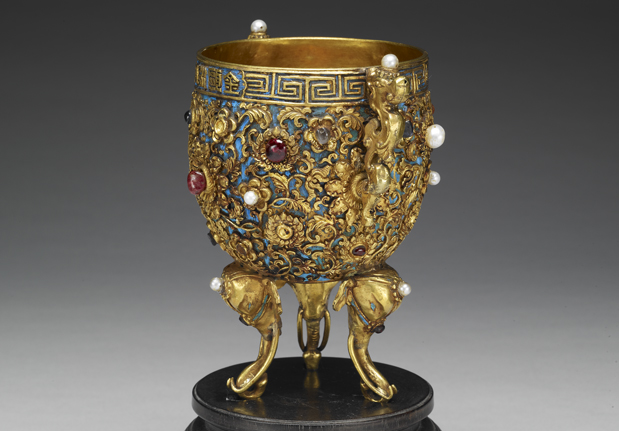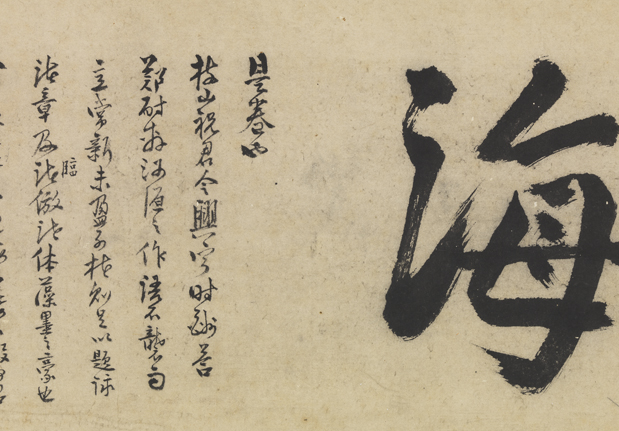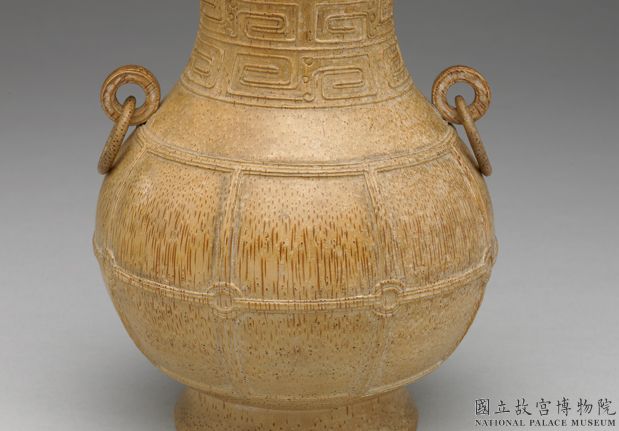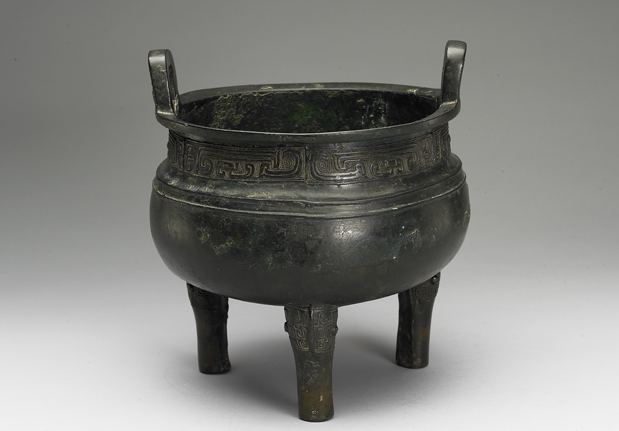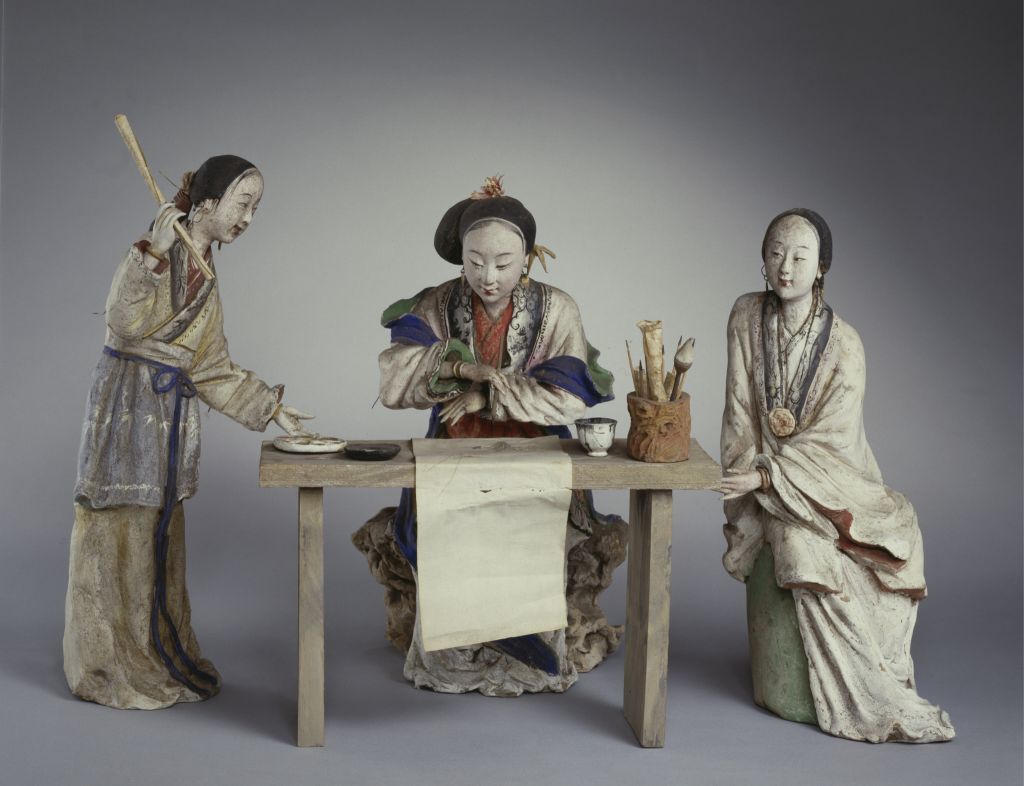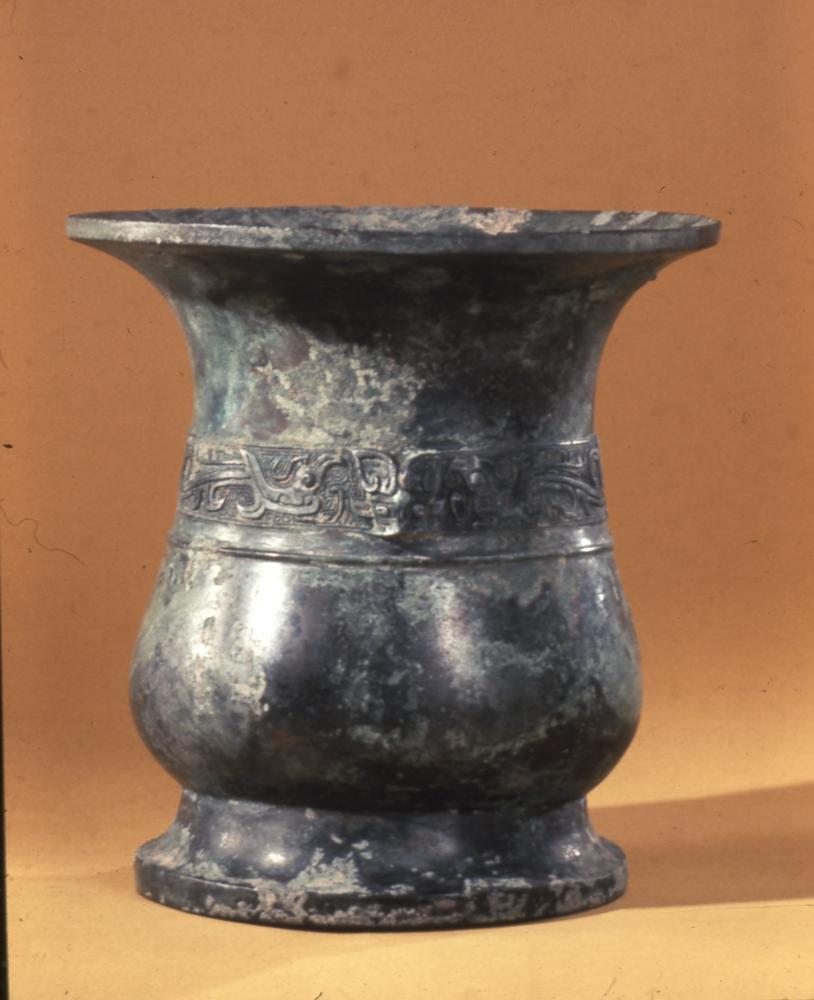Embroidered Thread Yang Yingju’s “Shengjing Fu” Volume
Embroidered Thread Yang Yingju’s “Shengjing Fu” Volume, in the Qianlong period of the Qing Dynasty, with 25 openings, each opening 32 centimeters vertically and 38 centimeters horizontally
“Shengjing Fu” was written by the emperor during his visit to the ancestral tomb in 1743, the eighth year of Qianlong’s reign in the Qing Dynasty. The content is to admonish the royal family to “abide by the old rules”, “think about the difficulties of creating, know the difficulty of achieving success, be conscientious and conscientious, and fear heaven and love others.”. Yang Yingju, then governor of Shandong Province, wrote the “Ode to Shengjing” in regular script and later embroidered it into a volume to pay tribute to Emperor Qianlong. Later, although Yang Yingju was convicted and ordered to commit suicide by the emperor, this calligraphy and embroidery work has remained
The album is originally mounted. The cover of a bright yellow satin embroidered multicolored golden dragon is decorated with auspicious clouds and sea water river cliff patterns. The back cover is made of bright yellow satin embroidered with bats and miscellaneous treasures, decorated with multicolored auspicious clouds, which symbolizes happiness, celebration, and auspiciousness. The white paper provided at the front and back is decorated with embroidered blue dragon edges, and wrapped with flowers, dark flowers, and gold paper
The inner embroidery page is made of white plain satin and embroidered with dark blue silk threads. The needle technique is not complicated, only common types of stitches such as neat stitches and oblique wound stitches, but the broken thread is extremely fine and the needle is very precise. The author completely followed the order of using the Chinese calligraphy brush to embroider it from horizontal to vertical, from left to right, and from left to right. Each stroke of silk is arranged in an oblique winding needle arrangement from left to right and from top to bottom, rather than moving the silk in a planar manner regardless of stroke order. The embroidery is regular and meticulous, with even and even stitches, and the vertical and horizontal strokes do not lose their brushwork. Each character has a silky and embossed three-dimensional feel, which has a unique artistic appeal compared to calligraphy.
![图片[1]-Embroidered Thread Yang Ying Ju’s Book of “Shengjing Fu”-China Archive](https://chinaarchive.net/Warring States period/tapestry and embroidery/12672[1024].jpg)
![绣线杨应琚书《盛京赋》冊之一 图片[2]-Embroidered Thread Yang Ying Ju’s Book of “Shengjing Fu”-China Archive](https://chinaarchive.net/Warring States period/tapestry and embroidery/12671[1024].jpg) 绣线杨应琚书《盛京赋》冊之一
绣线杨应琚书《盛京赋》冊之一![绣线杨应琚书《盛京赋》冊前后备纸 图片[3]-Embroidered Thread Yang Ying Ju’s Book of “Shengjing Fu”-China Archive](https://chinaarchive.net/Warring States period/tapestry and embroidery/12670[1024].jpg) 绣线杨应琚书《盛京赋》冊前后备纸
绣线杨应琚书《盛京赋》冊前后备纸![绣线杨应琚书《盛京赋》冊封面 图片[4]-Embroidered Thread Yang Ying Ju’s Book of “Shengjing Fu”-China Archive](https://chinaarchive.net/Warring States period/tapestry and embroidery/12669[1024].jpg) 绣线杨应琚书《盛京赋》冊封面
绣线杨应琚书《盛京赋》冊封面![绣线杨应琚书《盛京赋》冊之六 图片[5]-Embroidered Thread Yang Ying Ju’s Book of “Shengjing Fu”-China Archive](https://chinaarchive.net/Warring States period/tapestry and embroidery/12676[1024].jpg) 绣线杨应琚书《盛京赋》冊之六
绣线杨应琚书《盛京赋》冊之六![绣线杨应琚书《盛京赋》冊之五 图片[6]-Embroidered Thread Yang Ying Ju’s Book of “Shengjing Fu”-China Archive](https://chinaarchive.net/Warring States period/tapestry and embroidery/12675[1024].jpg) 绣线杨应琚书《盛京赋》冊之五
绣线杨应琚书《盛京赋》冊之五![绣线杨应琚书《盛京赋》冊之四 图片[7]-Embroidered Thread Yang Ying Ju’s Book of “Shengjing Fu”-China Archive](https://chinaarchive.net/Warring States period/tapestry and embroidery/12674[1024].jpg) 绣线杨应琚书《盛京赋》冊之四
绣线杨应琚书《盛京赋》冊之四![绣线杨应琚书《盛京赋》冊之三 图片[8]-Embroidered Thread Yang Ying Ju’s Book of “Shengjing Fu”-China Archive](https://chinaarchive.net/Warring States period/tapestry and embroidery/12673[1024].jpg) 绣线杨应琚书《盛京赋》冊之三
绣线杨应琚书《盛京赋》冊之三![绣线杨应琚书《盛京赋》冊之十 图片[9]-Embroidered Thread Yang Ying Ju’s Book of “Shengjing Fu”-China Archive](https://chinaarchive.net/Warring States period/tapestry and embroidery/12680[1024].jpg) 绣线杨应琚书《盛京赋》冊之十
绣线杨应琚书《盛京赋》冊之十![绣线杨应琚书《盛京赋》冊之九 图片[10]-Embroidered Thread Yang Ying Ju’s Book of “Shengjing Fu”-China Archive](https://chinaarchive.net/Warring States period/tapestry and embroidery/12679[1024].jpg) 绣线杨应琚书《盛京赋》冊之九
绣线杨应琚书《盛京赋》冊之九![绣线杨应琚书《盛京赋》冊之八 图片[11]-Embroidered Thread Yang Ying Ju’s Book of “Shengjing Fu”-China Archive](https://chinaarchive.net/Warring States period/tapestry and embroidery/12678[1024].jpg) 绣线杨应琚书《盛京赋》冊之八
绣线杨应琚书《盛京赋》冊之八![绣线杨应琚书《盛京赋》冊之七 图片[12]-Embroidered Thread Yang Ying Ju’s Book of “Shengjing Fu”-China Archive](https://chinaarchive.net/Warring States period/tapestry and embroidery/12677[1024].jpg) 绣线杨应琚书《盛京赋》冊之七
绣线杨应琚书《盛京赋》冊之七![绣线杨应琚书《盛京赋》冊之十四 图片[13]-Embroidered Thread Yang Ying Ju’s Book of “Shengjing Fu”-China Archive](https://chinaarchive.net/Warring States period/tapestry and embroidery/12684[1024].jpg) 绣线杨应琚书《盛京赋》冊之十四
绣线杨应琚书《盛京赋》冊之十四![绣线杨应琚书《盛京赋》冊之十三 图片[14]-Embroidered Thread Yang Ying Ju’s Book of “Shengjing Fu”-China Archive](https://chinaarchive.net/Warring States period/tapestry and embroidery/12683[1024].jpg) 绣线杨应琚书《盛京赋》冊之十三
绣线杨应琚书《盛京赋》冊之十三![绣线杨应琚书《盛京赋》冊之十二 图片[15]-Embroidered Thread Yang Ying Ju’s Book of “Shengjing Fu”-China Archive](https://chinaarchive.net/Warring States period/tapestry and embroidery/12682[1024].jpg) 绣线杨应琚书《盛京赋》冊之十二
绣线杨应琚书《盛京赋》冊之十二![绣线杨应琚书《盛京赋》冊之十一 图片[16]-Embroidered Thread Yang Ying Ju’s Book of “Shengjing Fu”-China Archive](https://chinaarchive.net/Warring States period/tapestry and embroidery/12681[1024].jpg) 绣线杨应琚书《盛京赋》冊之十一
绣线杨应琚书《盛京赋》冊之十一![绣线杨应琚书《盛京赋》冊之十八 图片[17]-Embroidered Thread Yang Ying Ju’s Book of “Shengjing Fu”-China Archive](https://chinaarchive.net/Warring States period/tapestry and embroidery/12688[1024].jpg) 绣线杨应琚书《盛京赋》冊之十八
绣线杨应琚书《盛京赋》冊之十八![绣线杨应琚书《盛京赋》冊之十七 图片[18]-Embroidered Thread Yang Ying Ju’s Book of “Shengjing Fu”-China Archive](https://chinaarchive.net/Warring States period/tapestry and embroidery/12687[1024].jpg) 绣线杨应琚书《盛京赋》冊之十七
绣线杨应琚书《盛京赋》冊之十七![绣线杨应琚书《盛京赋》冊之十六 图片[19]-Embroidered Thread Yang Ying Ju’s Book of “Shengjing Fu”-China Archive](https://chinaarchive.net/Warring States period/tapestry and embroidery/12686[1024].jpg) 绣线杨应琚书《盛京赋》冊之十六
绣线杨应琚书《盛京赋》冊之十六![绣线杨应琚书《盛京赋》冊之十五 图片[20]-Embroidered Thread Yang Ying Ju’s Book of “Shengjing Fu”-China Archive](https://chinaarchive.net/Warring States period/tapestry and embroidery/12685[1024].jpg) 绣线杨应琚书《盛京赋》冊之十五
绣线杨应琚书《盛京赋》冊之十五![绣线杨应琚书《盛京赋》冊之二十二 图片[21]-Embroidered Thread Yang Ying Ju’s Book of “Shengjing Fu”-China Archive](https://chinaarchive.net/Warring States period/tapestry and embroidery/12692[1024].jpg) 绣线杨应琚书《盛京赋》冊之二十二
绣线杨应琚书《盛京赋》冊之二十二![绣线杨应琚书《盛京赋》冊之二十一 图片[22]-Embroidered Thread Yang Ying Ju’s Book of “Shengjing Fu”-China Archive](https://chinaarchive.net/Warring States period/tapestry and embroidery/12691[1024].jpg) 绣线杨应琚书《盛京赋》冊之二十一
绣线杨应琚书《盛京赋》冊之二十一![绣线杨应琚书《盛京赋》冊之二十 图片[23]-Embroidered Thread Yang Ying Ju’s Book of “Shengjing Fu”-China Archive](https://chinaarchive.net/Warring States period/tapestry and embroidery/12690[1024].jpg) 绣线杨应琚书《盛京赋》冊之二十
绣线杨应琚书《盛京赋》冊之二十![绣线杨应琚书《盛京赋》冊之十九 图片[24]-Embroidered Thread Yang Ying Ju’s Book of “Shengjing Fu”-China Archive](https://chinaarchive.net/Warring States period/tapestry and embroidery/12689[1024].jpg) 绣线杨应琚书《盛京赋》冊之十九
绣线杨应琚书《盛京赋》冊之十九![绣线杨应琚书《盛京赋》冊封底 图片[25]-Embroidered Thread Yang Ying Ju’s Book of “Shengjing Fu”-China Archive](https://chinaarchive.net/Warring States period/tapestry and embroidery/12696[1024].jpg) 绣线杨应琚书《盛京赋》冊封底
绣线杨应琚书《盛京赋》冊封底![绣线杨应琚书《盛京赋》冊之二十五 图片[26]-Embroidered Thread Yang Ying Ju’s Book of “Shengjing Fu”-China Archive](https://chinaarchive.net/Warring States period/tapestry and embroidery/12695[1024].jpg) 绣线杨应琚书《盛京赋》冊之二十五
绣线杨应琚书《盛京赋》冊之二十五![绣线杨应琚书《盛京赋》冊之二十四 图片[27]-Embroidered Thread Yang Ying Ju’s Book of “Shengjing Fu”-China Archive](https://chinaarchive.net/Warring States period/tapestry and embroidery/12694[1024].jpg) 绣线杨应琚书《盛京赋》冊之二十四
绣线杨应琚书《盛京赋》冊之二十四![绣线杨应琚书《盛京赋》冊之二十三 图片[28]-Embroidered Thread Yang Ying Ju’s Book of “Shengjing Fu”-China Archive](https://chinaarchive.net/Warring States period/tapestry and embroidery/12693[1024].jpg) 绣线杨应琚书《盛京赋》冊之二十三
绣线杨应琚书《盛京赋》冊之二十三
